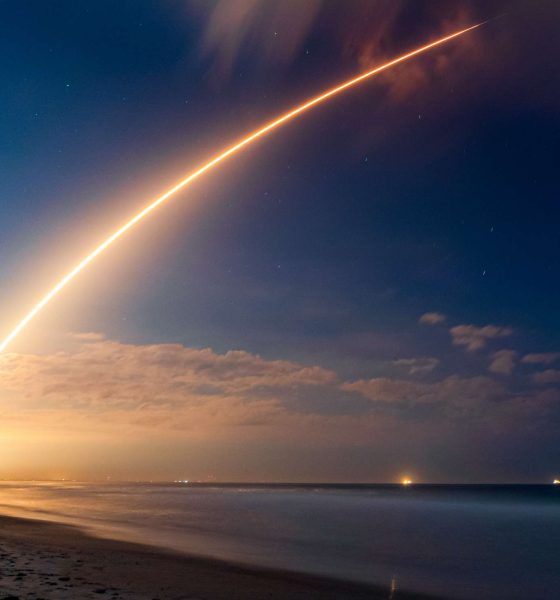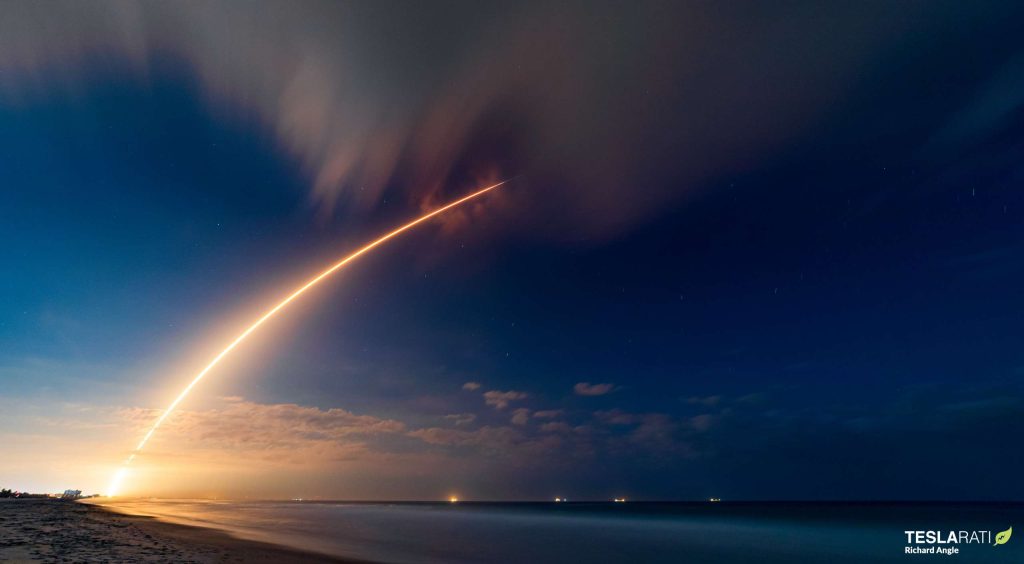

News
SpaceX Starlink Gen2 mission marks Falcon 9 rocket’s 200th successful launch
A day and a half after its 200th launch overall, SpaceX’s Falcon 9 rocket has successfully launched for the 200th time.
Falcon 9 has only suffered two mission-related failures in flight: one partial failure in 2012 and a catastrophic failure in 2015. Falcon 9’s 2015 failure entirely destroyed the rocket and its cargo-carrying Dragon spacecraft before they reached orbit. Its 2012 failure only doomed a secondary Orbcomm satellite payload, while the primary mission – a Cargo Dragon supply delivery for NASA – was technically successful.
Excluding partial failures, Starlink 5-3 was SpaceX’s 200th successful Falcon 9 launch since the rocket debuted in June 2010. Indicative of the company’s aggressive launch cadence as of late, Falcon 9 completed its 200th launch overall (199th success) less than two days prior, on January 31st.
The update that's rolling out to the fleet makes full use of the front and rear steering travel to minimize turning circle. In this case a reduction of 1.6 feet just over the air— Wes (@wmorrill3) April 16, 2024
Starlink 5-3 was SpaceX’s third launch for its Starlink Gen2 constellation, though the mission carried 53 ordinary Starlink V1.5 satellites. Oddly, the Starlink 5-2 mission carried 56 Starlink V1.5 satellites and set a new record for the heaviest SpaceX and Falcon 9 payload on January 26th. Just a few weeks prior, Falcon 9’s Starlink 5-1 launch carried 54 satellites – a curious amount of variability for three missions launching the same type of satellite to similar orbits.
As previously discussed on Teslarati, perhaps the single most important upgrade meant for SpaceX’s Starlink Gen2 constellation was a move to larger V2.0 satellites with almost a magnitude more usable bandwidth. But full-size Starlink V2.0 satellites can only be efficiently launched on SpaceX’s next-generation Starship rocket, which is likely at least 6-12 months away from its first satellite launch. SpaceX also told the FCC that it was building a mid-sized Starlink V2.0 satellite that could be launched on its existing Falcon rockets, but those compromised satellites have yet to appear.
Instead, SpaceX is launching Starlink V1.5 satellites under its Gen2 constellation license, which currently allows the company to launch and operate 7,500 of the almost 30,000 satellites it requested permission for. SpaceX’s Starlink Gen1 constellation is still ~1100 satellites away from completion. One possible explanation is that nearly all of the missing Gen1 satellites are headed to polar or semi-polar Earth orbits. Those polar satellites will spend far more time over regions of Earth with few to no Starlink customers, making them less capital-efficient than their mid-latitude siblings.
In other words, polar Starlink satellites – while necessary to ensure truly global coverage – effectively add less capacity to SpaceX’s network than they would if launched to midlatitude orbits. That appears to be exactly what SpaceX is currently doing with Starlink Gen2. The mid-latitude ‘shells’ of its Gen1 constellation are close to full, so the company is launching Starlink V1.5 satellites under its Gen2 license to increase the capacity of the overall network as quickly as possible.
Eventually, SpaceX will almost certainly replace those smaller, less capable V1.5 satellites with V2.0 satellites. In the near term, though, SpaceX has concluded that an inefficient gap-filler is better than waiting for a more optimal solution. It should not take long for the impact of Gen2 launches to be felt. Once the 163 ‘Gen2’ satellites launched in the last five weeks reach operational orbits, they will increase Starlink’s mid-latitude capacity by more than 5%.


Cybertruck
Tesla updates Cybertruck owners about key Powershare feature

Tesla is updating Cybertruck owners on its timeline of a massive feature that has yet to ship: Powershare with Powerwall.
Powershare is a bidirectional charging feature exclusive to Cybertruck, which allows the vehicle’s battery to act as a portable power source for homes, appliances, tools, other EVs, and more. It was announced in late 2023 as part of Tesla’s push into vehicle-to-everything energy sharing, and acting as a giant portable charger is the main advantage, as it can provide backup power during outages.
Cybertruck’s Powershare system supports both vehicle-to-load (V2L) and vehicle-to-home (V2H), making it flexible and well-rounded for a variety of applications.
However, even though the feature was promised with Cybertruck, it has yet to be shipped to vehicles. Tesla communicated with owners through email recently regarding Powershare with Powerwall, which essentially has the pickup act as an extended battery.
Powerwall discharge would be prioritized before tapping into the truck’s larger pack.
However, Tesla is still working on getting the feature out to owners, an email said:
“We’re writing to let you know that the Powershare with Powerwall feature is still in development and is now scheduled for release in mid-2026.
This new release date gives us additional time to design and test this feature, ensuring its ability to communicate and optimize energy sharing between your vehicle and many configurations and generations of Powerwall. We are also using this time to develop additional Powershare features that will help us continue to accelerate the world’s transition to sustainable energy.”
Owners have expressed some real disappointment in Tesla’s continuous delays in releasing the feature, as it was expected to be released by late 2024, but now has been pushed back several times to mid-2026, according to the email.
Foundation Series Cybertruck buyers paid extra, expecting the feature to be rolled out with their vehicle upon pickup.
Cybertruck’s Lead Engineer, Wes Morrill, even commented on the holdup:
As a Cybertruck owner who also has Powerwall, I empathize with the disappointed comments.
To their credit, the team has delivered powershare functionality to Cybertruck customers who otherwise have no backup with development of the powershare gateway. As well as those with solar…
— Wes (@wmorrill3) December 12, 2025
He said that “it turned out to be much harder than anticipated to make powershare work seamlessly with existing Powerwalls through existing wall connectors. Two grid-forming devices need to negotiate who will form and who will follow, depending on the state of charge of each, and they need to do this without a network and through multiple generations of hardware, and test and validate this process through rigorous certifications to ensure grid safety.”
It’s nice to see the transparency, but it is justified for some Cybertruck owners to feel like they’ve been bait-and-switched.
News
Tesla’s northernmost Supercharger in North America opens

Tesla has opened its northernmost Supercharger in Fairbanks, Alaska, with eight V4 stalls located in one of the most frigid cities in the U.S.
Located just 196 miles from the Arctic Circle, Fairbanks’s average temperature for the week was around -12 degrees Fahrenheit. However, there are plenty of Tesla owners in Alaska who have been waiting for more charging options out in public.
There are only 36 total Supercharger stalls in Alaska, despite being the largest state in the U.S.
Eight Superchargers were added to Fairbanks, which will eventually be a 48-stall station. Tesla announced its activation today:
North America’s northernmost Supercharger Fairbanks, AK (8 stalls) opened to public. https://t.co/M4l04DZ6B5 pic.twitter.com/zyL6bDuA93
— Tesla Charging (@TeslaCharging) December 12, 2025
The base price per kWh is $0.43 at the Fairbanks Supercharger. Thanks to its V4 capabilities, it can charge at speeds up to 325 kW.
Despite being the northernmost Supercharger in North America, it is not even in the Top 5 northernmost Superchargers globally, because Alaska is south of Norway. The northernmost Supercharger is in Honningsvåg, Norway. All of the Top 5 are in the Scandanavian country.
Tesla’s Supercharger expansion in 2025 has been impressive, and although it experienced some early-quarter slowdowns due to V3-to-V4 hardware transitions, it has been the company’s strongest year for deployments.
🚨🚨 Tesla Supercharging had a HUGE year, and they deserve to be recognized.
🍔 Opened Tesla Diner, a drive-in movie theater with awesome, Chef-curated cuisine
🔌 Gave access to Superchargers to several EV makers, including Hyundai, Genesis, Mercedes-Benz, Kia, Lucid, Toyota,… pic.twitter.com/yYT2QEbqoW
— TESLARATI (@Teslarati) December 10, 2025
Through the three quarters of 2025, the company has added 7,753 stations and 73,817 stalls across the world, a 16 percent increase in stations and an 18 percent increase in stalls compared to last year.
Tesla is on track to add over 12,000 stalls for the full year, achieving an average of one new stall every hour, an impressive statistic.
Recently, the company wrapped up construction at its Supercharger Oasis in Lost Hills, California, a 168-stall Supercharger that Tesla Solar Panels completely power. It is the largest Supercharger in the world.
News
Tesla shocks with latest Robotaxi testing move
Why Tesla has chosen to use a couple of Model S units must have a reason; the company is calculated in its engineering and data collection efforts, so this is definitely more than “we just felt like giving our drivers a change of scenery.”

Tesla Model S vehicles were spotted performing validation testing with LiDAR rigs in California today, a pretty big switch-up compared to what we are used to seeing on the roads.
Tesla utilizes the Model Y crossover for its Robotaxi fleet. It is adequately sized, the most popular vehicle in its lineup, and is suitable for a wide variety of applications. It provides enough luxury for a single rider, but enough room for several passengers, if needed.
However, the testing has seemingly expanded to one of Tesla’s premium flagship offerings, as the Model S was spotted with the validation equipment that is seen entirely with Model Y vehicles. We have written several articles on Robotaxi testing mules being spotted across the United States, but this is a first:
🚨 Tesla is using Model S vehicles fitted with LiDAR rigs to validate FSD and Robotaxi, differing from the Model Ys that it uses typically
Those Model Y vehicles have been on the East Coast for some time. These Model S cars were spotted in California https://t.co/CN9Bw5Wma8 pic.twitter.com/UE55hx5mdd
— TESLARATI (@Teslarati) December 11, 2025
Why Tesla has chosen to use a couple of Model S units must have a reason; the company is calculated in its engineering and data collection efforts, so this is definitely more than “we just felt like giving our drivers a change of scenery.”
It seems to hint that Tesla could add a premium, more luxury offering to its Robotaxi platform eventually. Think about it: Uber has Uber Black, Lyft has Lyft Black. These vehicles and services are associated with a more premium cost as they combine luxury models with more catered transportation options.
Tesla could be testing the waters here, and it could be thinking of adding the Model S to its fleet of ride-hailing vehicles.
Reluctant to remove the Model S from its production plans completely despite its low volume contributions to the overall mission of transitioning the world to sustainable energy, the flagship sedan has always meant something. CEO Elon Musk referred to it, along with its sibling Model X, as continuing on production lines due to “sentimental reasons.”
However, its purpose might have been expanded to justify keeping it around, and why not? It is a cozy, premium offering, and it would be great for those who want a little more luxury and are willing to pay a few extra dollars.
Of course, none of this is even close to confirmed. However, it is reasonable to speculate that the Model S could be a potential addition to the Robotaxi fleet. It’s capable of all the same things the Model Y is, but with more luxuriousness, and it could be the perfect addition to the futuristic fleet.








